
TL H 6753
LMC835
Digital
Controlled
Graphic
Equalizer
February 1995
LMC835 Digital Controlled Graphic Equalizer
General Description
The LMC835 is a monolithic digitally-controlled graphic
equalizer CMOS LSI for Hi-Fi audio The LMC835 consists
of a Logic section and a Signal Path section made of analog
switches and thin-film silicon-chromium resistor networks
The LMC835 is used with external resonator circuits to
make a stereo equalizer with seven bands
g
12 dB or
g
6
dB gain range and 25 steps each Only three digital inputs
are needed to control the equalization The LMC835 makes
it easy to build a mP-controlled equalizer
The signal path is designed for very low noise and distor-
tion resulting in very high performance compatible with
PCM audio
Features
Y
No volume controls required
Y
Three-wire interface
Y
14 bands 25 steps each
Y
g
12 dB or
g
6 dB gain ranges
Y
Low noise and distortion
Y
TTL CMOS logic compatible
Applications
Y
Hi-Fi equalizer
Y
Receiver
Y
Car stereo
Y
Musical instrument
Y
Tape equalization
Y
Mixer
Y
Volume controller
Connection Diagrams
Dual-In-Line Package
TL H 6753 � 1
Top View
Order Number LMC835N
See NS Package N28B
Molded Chip Carrier Package
TL H 6753 � 26
Top View
Order Number LMC835V
See NS Package V28A
C1995 National Semiconductor Corporation
RRD-B30M75 Printed in U S A
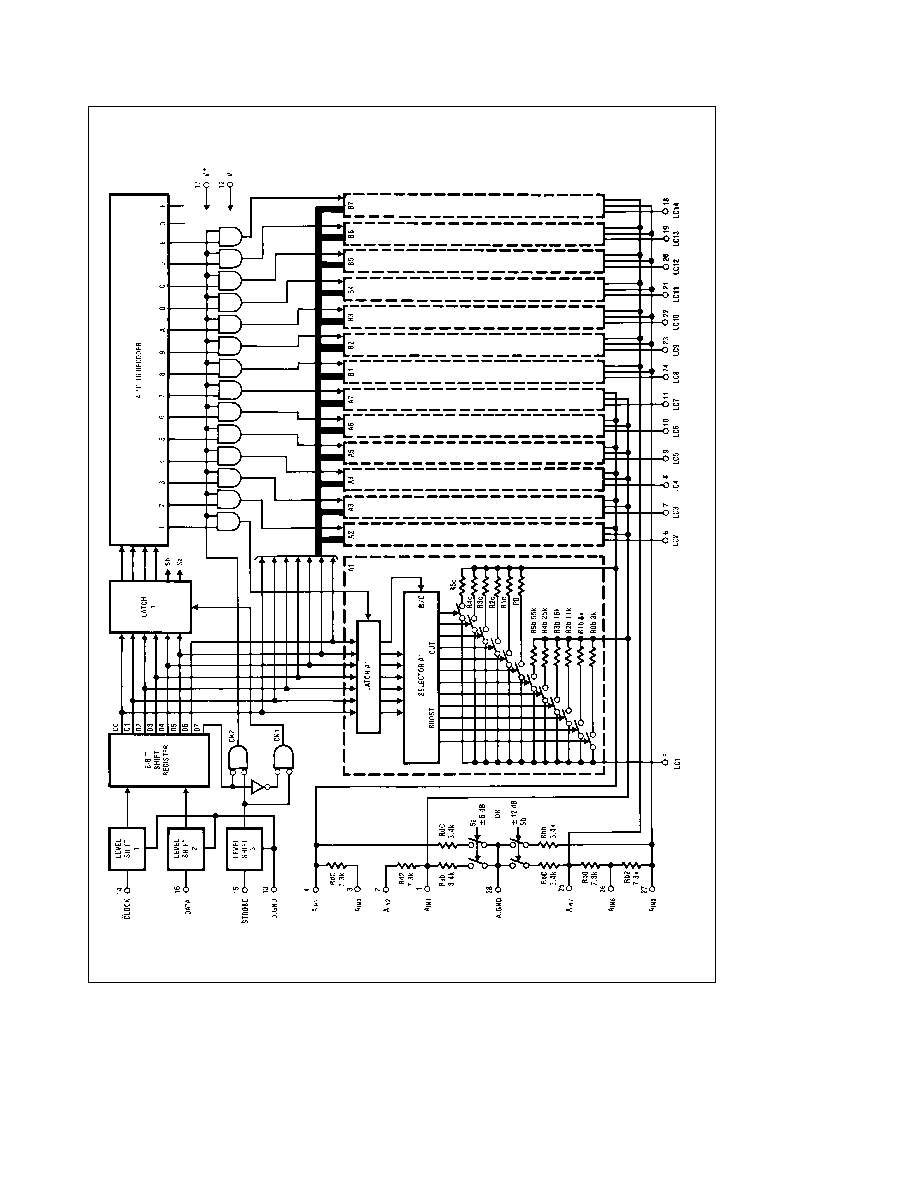
Block Diagram
TLH6753
�
2
2

Absolute Maximum Ratings
If Military Aerospace specified devices are required
please contact the National Semiconductor Sales
Office Distributors for availability and specifications
Supply Voltage V
DD
b
V
SS
18V
Allowable Input Voltage (Note 1)
V
SS
b
0 3V
to V
DD
a
0 3V
Storage Temperature T
stg
b
60 C to
a
150 C
Lead Temperature (Soldering 10 sec) N Pkg
a
260 C
Lead Temperature V Pkg
Vapor Phase (60 sec)
a
215 C
Infrared (15 sec)
a
220 C
Operating Ratings
Supply Voltage V
DD
b
V
SS
5V to 16V
Digital Ground (Pin 13)
V
SS
to V
DD
Digital Input (Pins 14 15 16)
V
SS
to V
DD
Analog Input (Pins 1 2 3 4 25 26 27)
(Note 1)
V
SS
to V
DD
Operating Temperature T
opr
b
40 C to
a
85 C
Electrical Characteristics
(Note 2) V
DD
e
7 5V V
SS
e b
7 5V A GND
e
0V
LOGIC SECTION
Tested
Design
Unit
Symbol
Parameter
Test Conditions
Typ
Limit
Limit
(Limit)
(Note 3)
(Note 4)
I
DDL
Supply Current
Pins 14 15 16 are 0V
0 01
0 5
0 5
mA (Max)
I
SSL
Pins 14 15 16 are 0V
0 01
0 5
0 5
mA (Max)
I
DDH
Pins 14 15 16 are 5V
1 3
5
5
mA (Max)
I
SSH
Pins 14 15 16 are 5V
0 9
5
5
mA (Max)
V
IH
High-Level Input Voltage
Pins 14 15 16
1 8
2 3
2 5
V (Min)
V
IL
Low-Level Input Voltage
Pins 14 15 16
0 9
0 6
0 4
V (Max)
f
o
Clock Frequency
Pin 14
2000
500
500
kHz (Max)
t
w(STB)
Width of STB Input
See
Figure 1
0 25
1
1
m
s (Min)
t
setup
Data Setup Time
See
Figure 1
0 25
1
1
m
s (Min)
t
hold
Data Hold Time
See
Figure 1
0 25
1
1
m
s (Min)
t
cs
Delay from Rising Edge of CLOCK
See
Figure 1
0 25
1
1
m
s (Min)
to STB
I
IN
Input Current
Pins 14 15 16 0V
k
V
IN
k
5V
g
0 01
g
1
m
A (Max)
C
IN
Input Capacitance
Pins 14 15 16 f
e
1 MHz
5
pF
Note 1
Pins 2 3 and 26 have a maximum input voltage range of
g
22V for the typical application shown in
Figure 7
Note 2 Bold numbers
apply at temperature extremes All other numbers apply at T
A
e
25 C V
DD
e
7 5V V
SS
e b
7 5V D GND
e
A GND
e
0V as shown in the test
circuit
Figures 3 and 4
Note 3
Guaranteed and 100% production tested
Note 4
Guaranteed (but not 100% production tested) over the operating temperature range These limits are not used to calculate outgoing quality levels
Timing Diagram
TL H 6753 � 3
Note
To change the gain of the presently selected band it is not necessary to send DATA 1 (Band Selection) each time
FIGURE 1
3

Electrical Characteristics
(Note 2) V
DD
e
7 5V V
SS
e b
7 5V D GND
e
A GND
e
0V
SIGNAL PATH SECTION
Tested
Design
Unit
Symbol
Parameter
Test Conditions
Typ
Limit
Limit
(Limit)
(Note 3)
(Note 4)
E
A
Gain Error
A
V
e
0 dB
g
12 dB Range
0 1
0 5
0 5
dB (Max)
A
V
e
0 dB
g
6 dB Range
0 1
1
1
dB (Max)
A
V
e
g
1 dB
g
dB Range
0 1
0 5
0 6
dB (Max)
(R
5b
or R
5c
is ON)
A
V
e
g
2 dB
g
12 dB Range
0 1
0 5
0 6
dB (Max)
(R
4b
or R
4c
is ON)
A
V
e
g
3 dB
g
12 dB Range
0 1
0 5
0 6
dB (Max)
(R
3b
or R
3c
is ON)
A
V
e
g
4 dB
g
12 dB Range
0 1
0 5
0 7
dB (Max)
(R
2b
or R
2c
is ON)
A
V
e
g
5 dB
g
12 dB Range
0 1
0 5
0 7
dB (Max)
(R
1b
or R
1c
is ON)
A
V
e
g
9 dB
g
12 dB Range
0 2
1
1 3
dB (Max)
(R
0b
or R
0c
is ON)
THD
Total Harmonic
A
V
e
0 dB
g
12 dB Range
0 0015
%
Distortion
V
IN
e
4V
rms
f
e
1 kHz
A
V
e
12 dB
g
12 dB Range
V
IN
e
1V
rms
f
e
1 kHz
0 01
0 1
% (Max)
V
IN
e
1V
rms
f
e
20 kHz
0 1
0 5
% (Max)
A
V
e b
12 dB
g
12 dB Range
V
IN
e
4V
rms
f
e
1 kHz
0 01
0 1
% (Max)
V
IN
e
4V
rms
f
e
20 kHz
0 1
0 5
% (Max)
V
O Max
Maximum Output Voltage
A
V
e
0 dB
g
12 dB Range
5 5
5 1
5
V
rms
(Min)
THD
k
1% f
e
1 kHz
S N
Signal to Noise Ratio
A
V
e
0 dB
g
12 dB Range
114
dB
V
ref
e
1 V
rms
A
V
e
12 dB
g
12 dB Range
106
dB
V
ref
e
1V
rms
A
V
e b
12 dB
g
12 dB Range
116
dB
V
ref
e
1V
rms
I
LEAK
Leakage Current
A
V
e
0 dB
g
12 dB Range
(All internal switches are OFF)
Pin 2
a
3 Pin 26
500
nA (Max)
Pin 5EPin 11 Pin 18EPin 24
50
nA (Max)
Note 2 Boldface numbers
apply at temperature extremes All other numbers apply at T
A
e
25 C V
DD
e
7 5V V
SS
e b
7 5V D GND
e
A GND
e
0V as shown in the
test circuit
Figures 3 and 4
Note 3
Guaranteed and 100% production tested
Note 4
Guaranteed (but not 100% production tested) over the operating temperature range These limits are not used to calculate outgoing quality levels
Timing Diagrams
TL H 6753 � 4
Note
To change the gain of the presently selected band it is not necessary to send DATA 1 (Band Selection) each time
FIGURE 2
4

Truth Tables
DATA I (Band Selection)
D7
D6
D5
D4
D3
D2
D1
D0
H
X
L
L
L
L
L
L
H
X
L
L
L
L
L
H
H
X
L
L
L
L
H
L
H
X
L
L
L
L
H
H
H
X
L
L
L
H
L
L
H
X
L
L
L
H
L
H
H
X
L
L
L
H
H
L
H
X
L
L
L
H
H
H
H
X
L
L
H
L
L
L
H
X
L
L
H
L
L
H
H
X
L
L
H
L
H
L
H
X
L
L
H
L
H
H
H
X
L
L
H
H
L
L
H
X
L
L
H
H
L
H
H
X
L
L
H
H
H
L
H
X
L
L
H
H
H
H
H
X
L
H
Valid Binary Input
H
X
H
L
Valid Binary Input
H
X
H
H
Valid Binary Input
u
u
u
u
w
Band Code
x
j
k
l
m
j
DATA 1
k
Don't Care
l
Ch A
g
6 dB
g
12 dB Range
m
Ch B
g
6 dB
g
12 dB Range
(Ch A Band 1E7 Ch B Band 8E14)
Ch A
g
12 dB Range Ch B
g
12 dB Range No Band Selection
Ch A
g
12 dB Range Ch B
g
12 dB Range Band 1
Ch A
g
12 dB Range Ch B
g
12 dB Range Band 2
Ch A
g
12 dB Range Ch B
g
12 dB Range Band 3
Ch A
g
12 dB Range Ch B
g
12 dB Range Band 4
Ch A
g
12 dB Range Ch B
g
12 dB Range Band 5
Ch A
g
12 dB Range Ch B
g
12 dB Range Band 6
Ch A
g
12 dB Range Ch B
g
12 dB Range Band 7
Ch A
g
12 dB Range Ch B
g
12 dB Range Band 8
Ch A
g
12 dB Range Ch B
g
12 dB Range Band 9
Ch A
g
12 dB Range Ch B
g
12 dB Range Band 10
Ch A
g
12 dB Range Ch B
g
12 dB Range Band 11
Ch A
g
12 dB Range Ch B
g
12 dB Range Band 12
Ch A
g
12 dB Range Ch B
g
12 dB Range Band 13
Ch A
g
12 dB Range Ch B
g
12 dB Range Band 14
Ch A
g
12 dB Range Ch B
g
12 dB Range No Band Selection
Ch A
g
12 dB Range Ch B
g
6 dB Range Band 1E14
Ch A
g
6 dB Range Ch B
g
12 dB Range Band 1E14
Ch A
g
6 dB Range Ch B
g
6 dB Range Band 1E14
This is the gain if the
g
12 dB range is
selected by DATA I If the
g
6 dB
range is selected
then the values
shown must be approximately halved
See the characteristics curves for
more exact data
DATA II (Gain Selection)
D7
D6
D5
D4
D3
D2
D1
D0
Flat
L
X
L
L
L
L
L
L
1 dB Boost
L
H
H
L
L
L
L
L
2 dB Boost
L
H
L
H
L
L
L
L
3 dB Boost
L
H
L
L
H
L
L
L
4 dB Boost
L
H
L
L
L
H
L
L
5 dB Boost
L
H
L
L
L
L
H
L
6 dB Boost
L
H
L
H
L
L
H
L
7 dB Boost
L
H
H
L
H
L
H
L
8 dB Boost
L
H
L
H
L
H
H
L
9 dB Boost
L
H
L
L
L
L
L
H
10 dB Boost
L
H
H
L
H
L
L
H
11 dB Boost
L
H
H
L
H
H
L
H
12 dB Boost
L
H
H
L
H
H
H
H
$
1 dBE12 dB Cut
L
L
Valid Above Input
u
u
w
Gain Code
x
n
o
n
DATA II
o
Boost Cut
5

Test Circuits
TL H 6753 � 5
FIGURE 3 Test Circuit for AC Measurement
TL H 6753 � 6
FIGURE 4 Test Circuit for Leakage Current Measurement
6
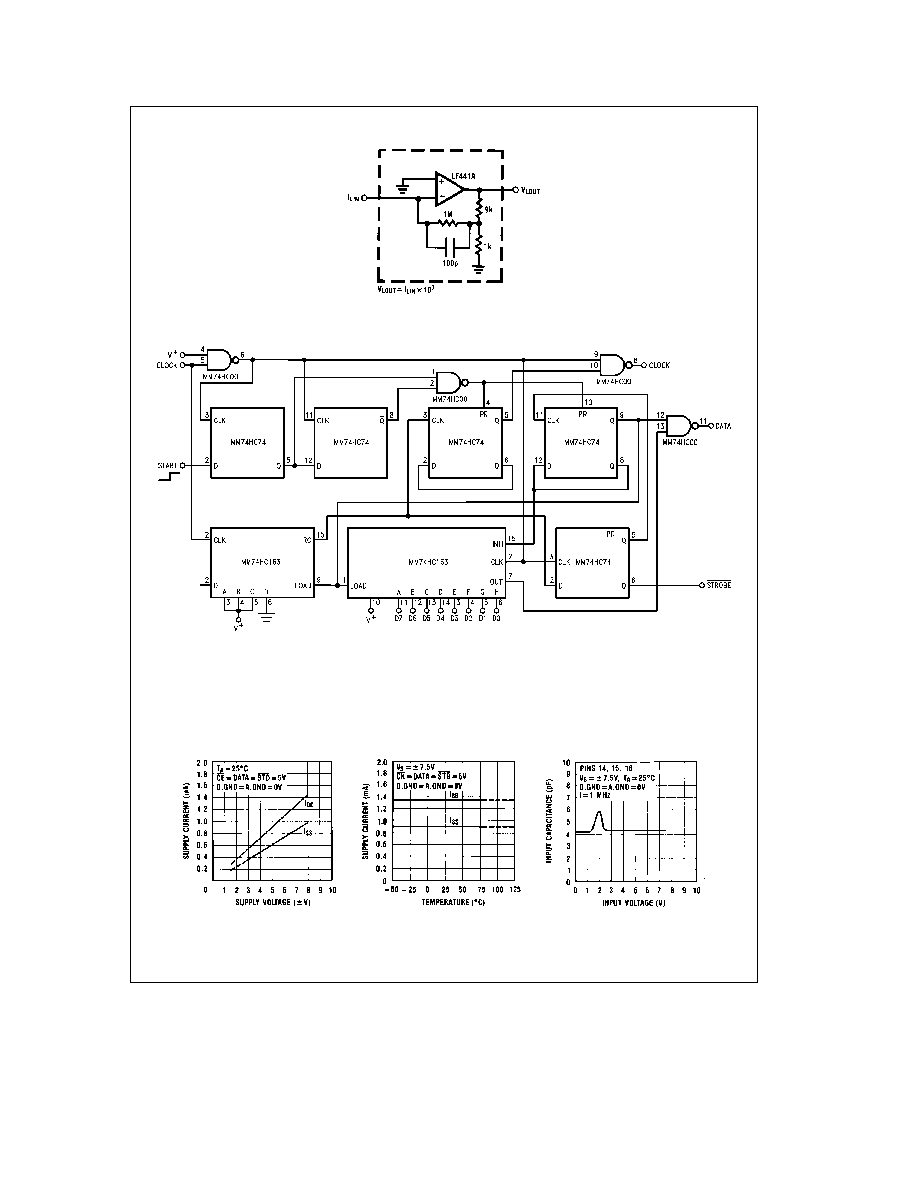
Test Circuits
(Continued)
TL H 6753 � 7
FIGURE 5 I to V Converter
TL H 6753 � 8
FIGURE 6 Simple Word Generator
Typical Performance Characteristics
Supply Current vs
Supply Voltage
Supply Current vs
Temperature
Input Capacitance vs
Input Voltage
TL H 6753 � 9
7

Typical Performance Characteristics
(Continued)
Maximum Output Voltage
vs Supply Voltage
Maximum Output Voltage
vs Temperature
Nominal Resistor
vs Temperature
Distortion vs Frequency
g
12 dB Range
Distortion vs Frequency
g
6 dB Range
Distortion vs Output Voltage
g
12 dB Range
Distortion vs Output Voltage
g
6 dB Range
Gain vs Frequency
g
12 dB Range (Boost)
Gain vs Frequency
g
12 dB Range (Cut)
Gain vs Frequency
g
6 dB Range (Boost)
Gain vs Frequency
g
6 dB Range (Cut)
Gain vs Temperature
TL H 6753 � 10
8

Typical Applications
TL H 6753 � 11
FIGURE 7 Stereo 7-Band Equalizer
TABLE I Tuned Circuit Elements
Q
0
e
3 5 Q
12dB
e
1 05
Z1
f
o
(Hz)
C
O
(F)
C
L
(F)
R
L
(X)
R
O
(X)
Z1
63
1m
0 1m
100k
680
Z2
160
0 47m
0 033m
100k
680
Z3
400
0 15m
0 015m
100k
680
Z4
1k
0 068m
0 0068m
82k
680
Z5
2 5k
0 022m
0 0033m
82k
680
Z6
6 3k
0 01m
0 0015m
62k
680
Z7
16k
0 0047m
680p
47k
680
TL H 6753 � 12
FIGURE 8 Tuned Circuit for Stereo
7-Band Equalizer (
Figure 7 )
L
0
e
C
L
R
L
R
0
f
0
e
1
2q
0
L
0
C
0
Q
0
e
0
L
0
C
0
R
0
2
Q
12 dB
e
R
0
Q
0
R
0
a
1590
9

Typical Applications
(Continued)
Performance Characteristics (Circuit of
Figure 7 )
LMC835 Gain vs Frequency
g
12 dB Range
(All Boost or Cut)
LMC835 Gain vs Frequency
g
12 dB Range
(1 kHz Boost or Cut)
LMC835 Gain vs Frequency
g
6 dB Range
(All Boost or Cut)
LMC835 Gain vs Frequency
g
6 dB Range
(1 kHz Boost or Cut)
TL H 6753 � 13
TL H 6753 � 14
FIGURE 9 12-Band Equalizer
10

Typical Applications
(Continued)
TABLE II Tuned Circuit Elements
Q
0
e
4 7 Q
12 dB
e
1 4
f
o
(Hz)
C
o
(F)
C
L
(F)
R
L
(X)
R
o
(X)
Z1
16
3 3m
0 47m
100k
680
Z2
31 5
15m
0 22m
110k
680
Z3
63
1m
0 1m
100k
680
Z4
125
0 39m
0 068m
91k
680
Z5
250
0 22m
0 033m
82k
680
Z6
500
0 1m
0 015m
100k
680
Z7
1k
0 047m
0 01m
82k
680
Z8
2k
0 022m
0 0047m
91k
680
Z9
4k
0 01m
0 0022m
110k
680
Z10
8k
0 0068m
0 001m
82k
680
Z11
16k
0 0033m
680p
62k
680
Z12
32k
0 0015m
470p
68k
510
TL H 6753 � 15
FIGURE 10 Tuned Circuit for
12-Band Equalizer (
Figure 9 )
Performance Characteristics (Circuit of Figure 9)
12 Band Equalizer Application
LMC835 Gain vs Frequency
g
6 dB Range
(All Boost or Cut)
LMC835 12 Band E Q Application
Gain vs Frequency
g
12 dB Range
(1 kHz Boost or Cut)
12 Band Equalizer Application
LMC835 Gain vs Frequency
g
12 dB Range
(All Boost or Cut)
LMC835 12 Band E Q Application
Gain vs Frequency
g
6dB Range
(1 kHz Boost or Cut)
TL H 6753 � 16
L
0
e
C
L
R
L
R
0
f
0
e
1
2q
0
L
0
C
0
Q
0
e
0
L
0
C
0
R
0
2
Q
12 dB
e
R
0
Q
0
R
0
a
1590
11
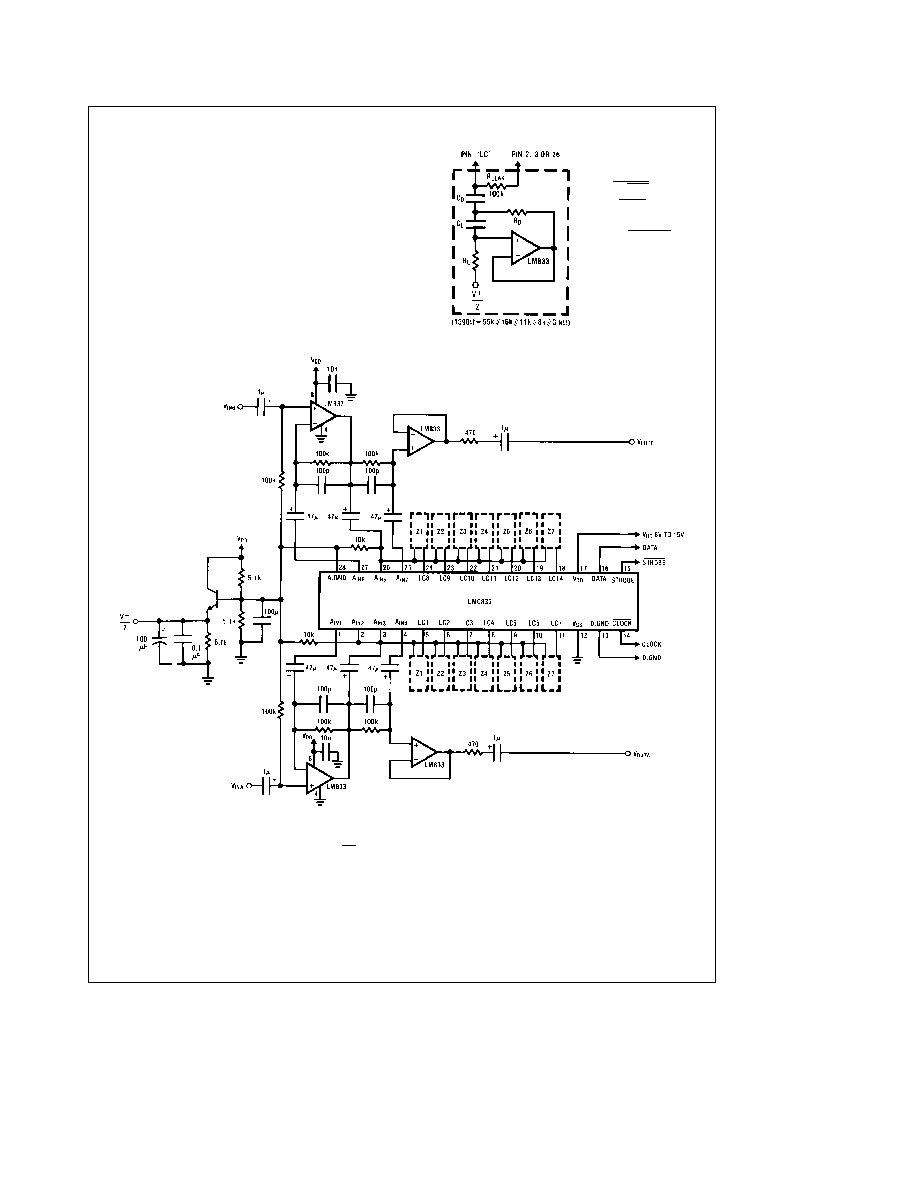
Typical Applications
(Continued)
L
o
e
C
L
R
L
R
O
F
o
e
1
2q
0
L
O
C
O
Q
O
e
0
C
O
R
O
2
Q
12 dB
e
R
O
Q
O
R
O
a
15 C
TL H 6753 � 25
TL H 6753 � 17
The
V
a
2
output is used to bias the gyrators
FIGURE 11 Single Supply Stereo Equalizer
12
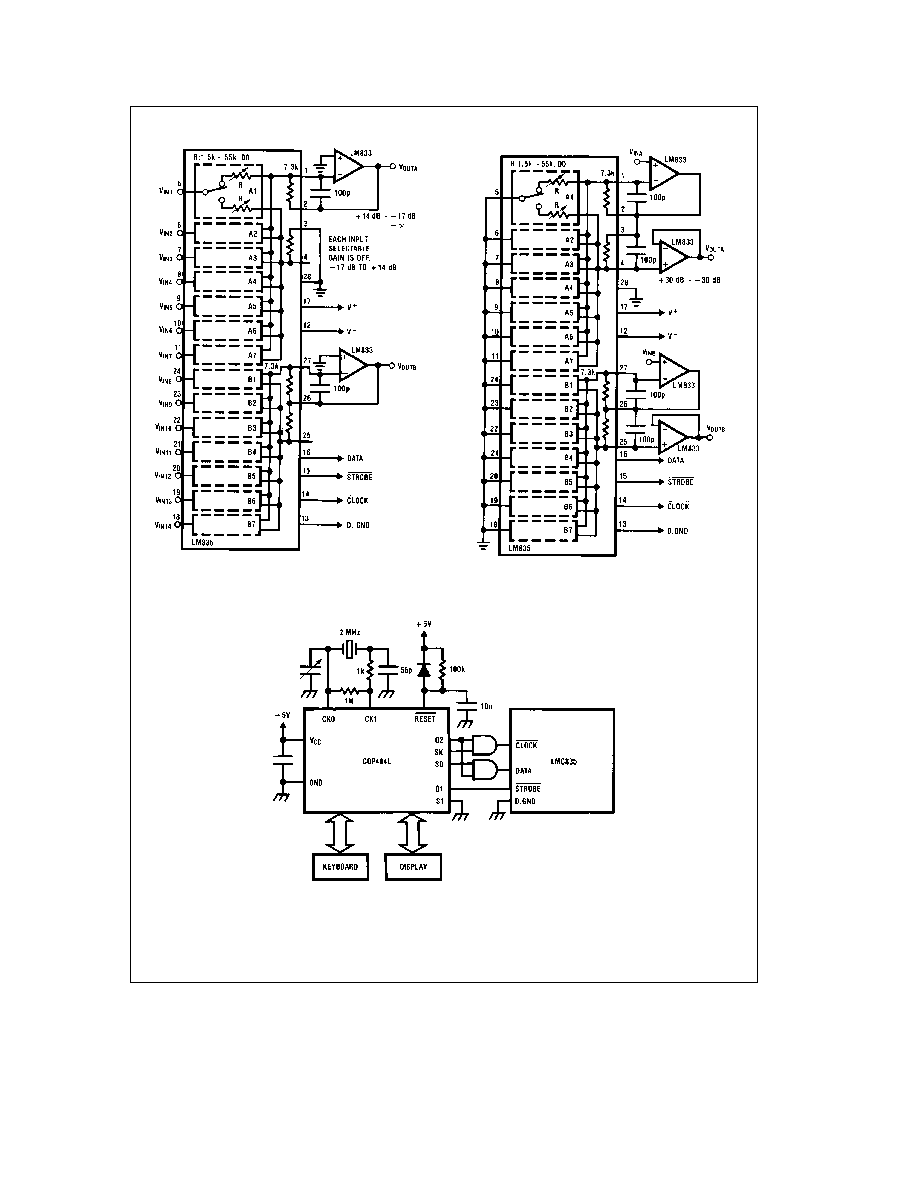
Typical Applications
(Continued)
TL H 6753 � 18
FIGURE 12 Stereo 7-Input 1-Output Mixers
(THD is not as low as equalizer circuit)
TL H 6753 � 19
FIGURE 13 Stereo Volume Control Very Low THD
TL H 6753 � 20
FIGURE 14 LMC835-COP404L CPU Interface
13

Typical Applications
(Continued)
Sample Subroutine Program for
Figure 14 LMC835-COP404L CPU Interface
HEX
CODE
LABEL
MNEMONICS
COMMENTS
3F
LMC835
LBI
3F
POINT TO RAMADDRESS 3F
05
SEND
LD
RAMDATA TO A
22
SC
SET CARRY
335F
OGI
SET PORT G
4 1111 OPEN THE AND GATES
4F
XAS
SWAP A AND SIO
CLOCK START
05
LD
RAMDATA TO A
MAKE SURE A
4 DATA
07
XDS
SWAP A AND RAMDATA
RAMADDRESS
4RAMADDRESS11
05
LD
RAMDATA TO A
4F
XAS
SWAP A AND SIO
05
LD
RAMDATA TO A
MAKE SURE A
4NEWDATA
07
XDS
SWAP A AND RAMDATA
RAMADDRESS
4RAMADDRESS11
32
RC
RESET CARRY
4F
XAS
SWAP A AND SIO
CLOCK STOP
335D
OGJ
13
SET PORT G
41101 MAKE STROBE LOW
335B
OGI
11
SET PORT G
41011 MAKE STROBE HIGH CLOSE THE
GATES
4E
CBA
BD TO A
43
AISC
3
RAMADDRESS
k
3C THEN RETURN
48
RET
80
JP
SEND
RAM
ADDRESS
COMMENTS
3C
DATA
GAIN DATA D4
1D7
3D
DATA
GAIN DATA D0
1D3
3E
DATA
BAND DATA D4
1D7
3F
DATA
BAND DATA D0
1D3
Application Hints
SWITCHING NOISE
The LMC835 uses CMOS analog switches that have small
leakages (less than 50 nA) When a band is selected for flat
gain all the switches in that band are open and the resona-
tor circuit is not connected to the LMC835 resistor network
It is only in the flat mode that the small leakage currents can
cause problems The input to the resonator circuit is usually
a capacitor and the leakage currents will slowly charge up
this capacitor to a large voltage if there is no resistive path
to limit it When the band is set to any value other than flat
the charge on the capacitor will be discharged by the resis-
tor network and there will be a transient at the output To
limit the size of this transient R
LEAK
is necessary
HOW TO AVOID SWITCHING NOISE DUE TO LEAKAGE
CURRENT
(Refer to
Figures 7 and 8 )
To avoid switching noise due to leakage currents when
changing the gain it is recommended to put R
LEAK
e
100
kX between Pin 3 and Pin 5
11 each Pin 26 and Pin 12
24 each The resistor limits the voltage that the capacitor
can charge to with minimal effects on the equalization The
frequency response change due to R
LEAK
are shown in
Fig-
ure 15 The gain error is only 0 2 dB and Q error is only 5%
at 12 dB boost or cut
SIMPLE WORD GENERATOR
(Figure 6)
Circuit operation revolves around an MM74HC165 parallel-
in serial-out shift register Data bits D0 through D7 are ap-
plied to the parallel of the MM74HC165 from 8 toggle
switches The bits are shifted out to the DATA input of the
LMC835 in sync with the clock When all data bits have
been loaded CLOCK is inhibited and a STROBE pulse is
generated this sequence is initiated by a START pulse
LMC835-COP404L CPU INTERFACE
(Refer to
Figure 14 )
The diagram shows AND gates between the COP and the
LMC835 These permit G2 to inhibit the CLOCK and DATA
lines (SK and SO) during a STROBE (G1) pulse This func-
tion may also be implemented in software As shown in
Fig-
ure 2 the data groups are shifted in D0 first Data is loaded
on positive clock edges
POWER SUPPLIES
These applications show LM317 337 regulators for the
g
7 5V supplies for the LMC835 Since the latter draws only
5 mA max 1k series dropping resistors from the
g
15V op
amp supply and a pair of 7 5V zeners and bypass caps will
also suffice
14

Application Hints
(Continued)
MODEL
TL H 6753 � 21
RESULT
TL H 6753 � 22
FIGURE 15 Effect of R
LEAK
REDUCING EXTERNAL COMPONENTS
The typical application shown in
Figure 7 is switching noise
free The DC-coupled circuit in
Figure 16 is also switching
noise free except at 12 dB 6 dB switch turn ON OFF This
switching noise is caused by the I
bias
and V
offset
of the op
amps Selecting a low I
bias
and V
offset
op amp can minimize
the switching noise due to the 12 dB 6 dB switch The DC-
coupled application can also eliminate the R
F
e
100k resis-
tors with only a 0 5 dB gain error at 12 dB boost or cut
AC COUPLING
TL H 6753 � 23
DC COUPLING
TL H 6753 � 24
FIGURE 16 Reducing External Components
15

16

Physical Dimensions
inches (millimeters)
Order Number LMC835N
NS Package N28B
17
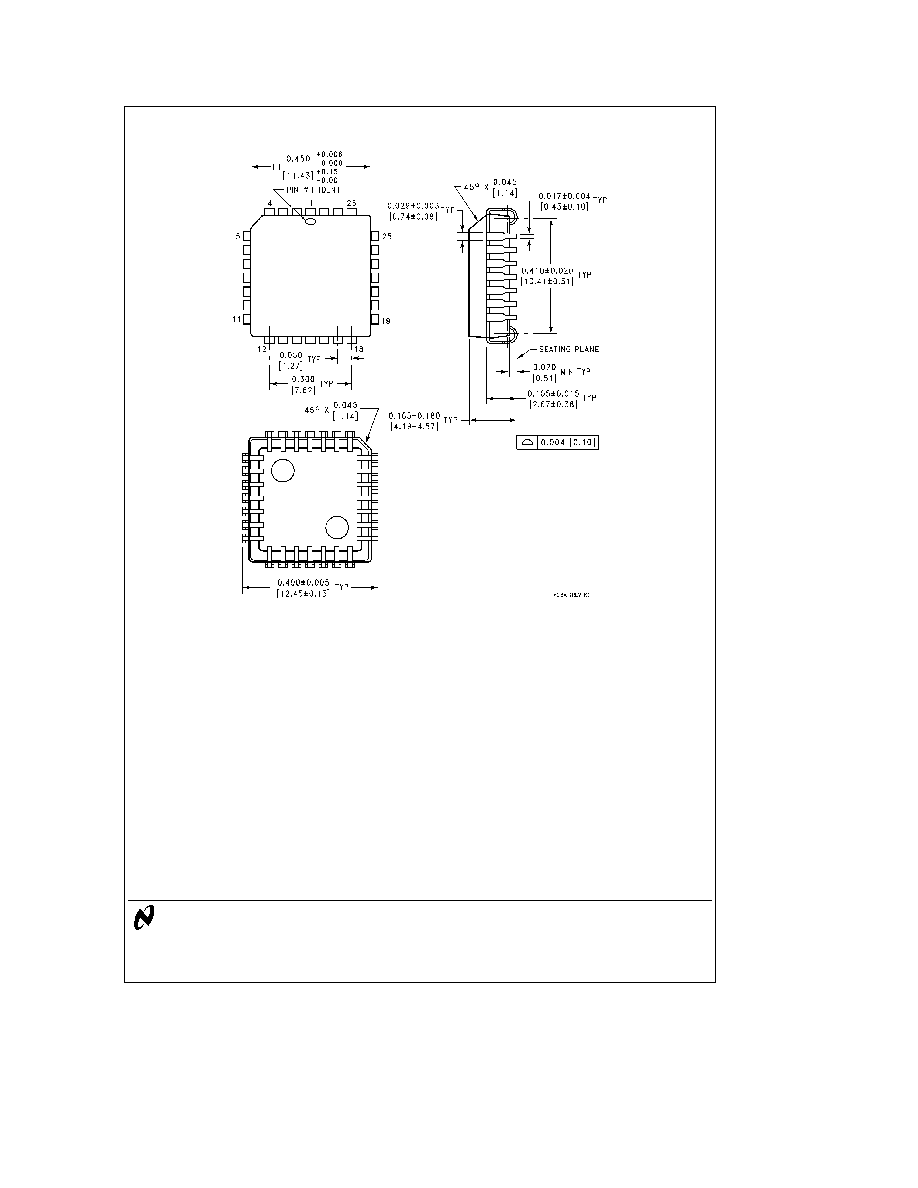
LMC835
Digital
Controlled
Graphic
Equalizer
Physical Dimensions
inches (millimeters) (Continued)
Order Number LMC835V
NS Package V28A
LIFE SUPPORT POLICY
NATIONAL'S PRODUCTS ARE NOT AUTHORIZED FOR USE AS CRITICAL COMPONENTS IN LIFE SUPPORT
DEVICES OR SYSTEMS WITHOUT THE EXPRESS WRITTEN APPROVAL OF THE PRESIDENT OF NATIONAL
SEMICONDUCTOR CORPORATION As used herein
1 Life support devices or systems are devices or
2 A critical component is any component of a life
systems which (a) are intended for surgical implant
support device or system whose failure to perform can
into the body or (b) support or sustain life and whose
be reasonably expected to cause the failure of the life
failure to perform when properly used in accordance
support device or system or to affect its safety or
with instructions for use provided in the labeling can
effectiveness
be reasonably expected to result in a significant injury
to the user
National Semiconductor
National Semiconductor
National Semiconductor
National Semiconductor
National Semiconductores
National Semiconductor
Corporation
GmbH
Japan Ltd
Hong Kong Ltd
Do Brazil Ltda
(Australia) Pty Ltd
2900 Semiconductor Drive
Livry-Gargan-Str 10
Sumitomo Chemical
13th Floor Straight Block
Rue Deputado Lacorda Franco
Building 16
P O Box 58090
D-82256 F4urstenfeldbruck
Engineering Center
Ocean Centre 5 Canton Rd
120-3A
Business Park Drive
Santa Clara CA 95052-8090
Germany
Bldg 7F
Tsimshatsui Kowloon
Sao Paulo-SP
Monash Business Park
Tel 1(800) 272-9959
Tel (81-41) 35-0
1-7-1 Nakase Mihama-Ku
Hong Kong
Brazil 05418-000
Nottinghill Melbourne
TWX (910) 339-9240
Telex 527649
Chiba-City
Tel (852) 2737-1600
Tel (55-11) 212-5066
Victoria 3168 Australia
Fax (81-41) 35-1
Ciba Prefecture 261
Fax (852) 2736-9960
Telex 391-1131931 NSBR BR
Tel (3) 558-9999
Tel (043) 299-2300
Fax (55-11) 212-1181
Fax (3) 558-9998
Fax (043) 299-2500
National does not assume any responsibility for use of any circuitry described no circuit patent licenses are implied and National reserves the right at any time without notice to change said circuitry and specifications

















